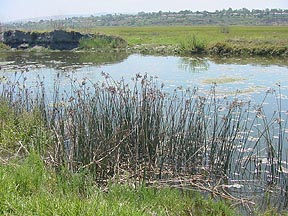Water Resources Program

Let's start basic: What is a watershed? A watershed is an area of land that drains into a lake or river. As rainwater and melting snow run downhill, they carry sediment and other materials into our streams, lakes, wetlands and groundwater.
Why is your watershed important? We all live in a watershed. Watersheds are the places we call home, where we work and where we play. Everyone relies on water and other natural resources to exist. What you and others do on the land impacts the quality and quantity of water and our other natural resources.
Healthy watersheds are vital for a healthy environment and economy. Our watersheds provide water for drinking, irrigation and industry. Many people also enjoy lakes and streams for their beauty and for boating, fishing and swimming. Wildlife also need healthy watersheds for food and shelter.
Managing the water and other natural resources is an effective and efficient way to sustain the local economy and environmental health.
Scientists and leaders now recognize the best way to protect the vital natural resources is to understand and manage them on a watershed basis. Everything that is done in a watershed affects the watershed's system.
Pollutants and water quality. In the past, most water quality problems were traced to the most obvious cause ... point-source pollution. This means the problem can be traced to a specific location such as a pipe or disposal site.
Technical and regulatory methods have been used to detect and control these problems. Much progress has been made in preventing further water quality problems from point sources.
However, water quality problems from nonpoint-source pollution are more difficult to isolate and control. These sources are often hard to identify and difficult to measure. This type of pollution results from a wide variety of activities over a wide area.
Nonpoint-source pollutants are in the water that runs off crop or forest land. Others include failing septic systems, parking lots, construction sites, irrigation systems and drainage systems. It can even result from automobile exhaust getting in the atmosphere and falling back to earth in the rain.
A partnership among all who live, work or play in the watershed can help identify concerns, educate those involved and encourage them to take action. Watershed management plans focus on prevention of pollution. This is easier and cheaper than trying to cleanup a watershed after the fact.
Understanding your watershed is the first step in protecting the water and other natural resources.
Understanding your watershed. The watershed where you live is a dynamic and unique place. It is a complex web of natural resources - soil, water, air, plants and animals. Yet, everyday activities can impact these resources, ultimately impacting our well-being and economic livelihood.
Features.Your watershed has many features that make it unique.
Size. One important feature is the size of the watershed. Some (like the Mississippi River basin) are very large and include many smaller river basins or watersheds. These smaller watersheds can be subdivided into even smaller areas. The ideal size for a voluntary partnership to work with is 50,000 acres or less. At this size your group will likely see water quality improvements sooner than in larger areas. Of course, in regions of the United States where ranchers, foresters and others manage large tracts of land, you may be working with a much larger watershed.
Boundary. Another important feature is the geographic boundary of the watershed. The boundary is formed by a ridge or high area from which water drains either toward or away from your watershed.
Terrain. The topography (terrain) is another important feature. How flat or steep the land is impacts how fast water drains. The faster the drainage, the more potential for flooding and increased soil erosion.
Soil type. Soil type is also important. For example, sandy soils allow the ground to soak up water faster. This reduces surface runoff, but can affect ground water. Clay soils, on the other hand, are tighter and do not allow as much water infiltration. This can lead to more runoff and soil erosion.
Other features. Whether your watershed drains into a stream or lake, the area nearest the water greatly affects water quality. This is why filter/buffer strips, wildlife habitat, wetlands and riparian areas are important aspects of your watershed.
Both filter/buffer strips and wetlands utilize nutrients and tie up sediment to help improve water quality. Wetlands also act as natural sponges to absorb peak flows of water and reduce flooding. Many fish and wildlife species rely on wetlands for rearing their young, and for food and shelter.
Uses. To fully understand your watershed, you'll also need to consider how it is used.
Land uses and trends. All activities within the watershed have an impact on its natural resources. Cities, homes, roads and factories modify the watershed and affect its natural resources. Farming, recreation, mining, construction and forestry can also significantly affect a watershed.
One trend you may want to note is whether or not more homes are being built in rural areas. This can lead to conflicts over watershed issues such as livestock odor, pesticide use or septic systems. It can also lead to significant changes in land use which can affect water quality and property values.
Natural resource uses. You may also find natural resources are used in many different ways in your watershed. Water can be used by municipalities and local industries. Farms also rely on water for irrigation and livestock. Many people enjoy water for recreational uses like fishing, swimming and boating. So the water quality and quantity are important to the watershed's stakeholders. Air quality, wildlife, soil quality and the other natural resources can also be important aspects of watershed management.
